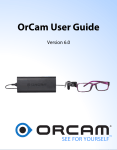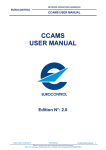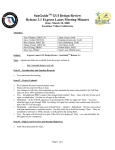Download SEE FOR YOURSELF
Transcript
SEE FOR YOURSELF FCC Compliance This equipment has been tested and found to comply with the limits for a Class B digital device, pursuant to Part 15 of the FCC rules. These limits are designed to provide reasonable protection against harmful interference in a residential installation. This equipment generates, uses and can radiate radio frequency energy and, if not installed and used in accordance with the instructions, may cause harmful interference to radio communications. However, there is no guarantee that interference will not occur in a particular installation. If this equipment does cause harmful interference to radio or television reception, which can be determined by turning the equipment off and on, the user is encouraged to try to correct the interference by one or more of the following measures: 1. Reorient or relocate the receiving antenna. 2. Increase the separation between the equipment and receiver. 3. Connect the equipment to an outlet on a circuit different from that to which the receiver is connected. 4. Consult the dealer or an experienced radio/TV technician. FCC Warning Modifications not expressly approved by the manufacturer could void the user authority to operate the equipment under FCC Rules. NOTE: THE MANUFACTURER IS NOT RESPONSIBLE FOR ANY RADIO OR TV INTERFERENCE CAUSED BY UNAUTHORIZED MODIFICATIONS TO THIS EQUIPMENT. SUCH MODIFICATIONS COULD VOID THE USER’S AUTHORITY TO OPERATE THE EQUIPMENT. i © 2014 OrCam Technologies Ltd. All rights reserved. OrCam™ is the trademark and brand name of OrCam Technologies Ltd. (“OrCam”) and OrCam is the sole proprietor of all the rights and all the intellectual property rights in this manual and/or any other document produced by OrCam relating thereto. The documents are protected by applicable intellectual property laws including and without limitation copyrights, patents, trademarks, know how, trade secrets, and international treaties. No license or rights are hereby transferred to the user of this manual and said manual shall remain the sole and exclusive property of OrCam. No part of this manual shall be used, reproduced, translated, converted, modified, adapted, displayed, stored in a retrieval system, communicated, or transmitted by any means, for any commercial purpose, including and without limitation, sale, resale, distribution, reproduction, license, rental, or lease without receiving written permission from OrCam. OrCam makes no express or implied representation or warranty as to the accuracy or completeness of the contents of this manual, which is provided “as is", and assumes no responsibility or liability for any errors or inaccuracies that may appear in this document or for any product that may be provided in association with this document. OrCam devices are intended to enhance the day-to-day lives of individuals with visual impairments. They are not substitutes for existing methods or forms of assistance and should not be relied upon in circumstances which are potentially life- or health-threatening or which could lead to financial loss. OrCam devices should especially never be relied upon to drive vehicles or operate heavy machinery of any kind. OrCam Inc. 99 Jericho Tpke, Ste 203 Jericho, NY 11753 Website: www.orcam.com Email: [email protected] OrCam User Manual Version 3.0 Table of Contents About the OrCam Device ............................................................. 1 Assembling the OrCam Device .................................................... 5 Getting Started ............................................................................ 8 Reading with OrCam .................................................................. 11 Object Learning Mode ............................................................... 17 Changing OrCam’s Voice ........................................................... 21 Instructions for Software Updates using SD Card ..................... 23 Troubleshooting ........................................................................ 27 OrCam System Messages .......................................................... 30 Cleaning the Device ................................................................... 33 OrCam Please Commands ......................................................... 34 iii OrCam User Manual Version 3.0 Safety Before using the OrCam device, read the following precautions carefully to avoid dangerous situations and to ensure ideal performance of your OrCam device. Handle your OrCam device with care. It can be damaged if dropped, burned, punctured, or crushed. The OrCam device is designed to work in ambient temperatures between 32° and 104° F (0° and 40° C). The device can be damaged if used outside of this temperature range. Store in a cool, dry place. OrCam is water resistant but not waterproof. This means that the Head Unit can withstand light rain or drizzle for short periods of time, although it is not recommended, as long as the Base Unit is covered and protected. Do not use OrCam in heavy rain, when at the beach or swimming pool, or in or near a bathtub or shower. Do not submerge OrCam in any type of liquid. Do not expose the device to chemicals, such as household cleaners, aerosol sprays, solvents, alcohol, or ammonia. Do not open the Head or Base Units. There is a cord connecting the Head and Base Units. Do not disconnect this cord from either the Head or Base Unit. Do not pull on the cord or cut it in any way. Should you have a problem operating the OrCam device and believe there is something wrong with the device, do not attempt to repair it by yourself. Only qualified OrCam personnel may repair or service your device. Unauthorized repairs may void your warrantee. iv OrCam User Manual Version 3.0 Do not attempt to replace the battery; you may damage the battery, which could cause overheating and even injury. Use only the AC adapter supplied with your device. Using another AC adapter may void your warranty and could cause severe injury. Do not force a connector into a port or apply excessive pressure to a button. This may cause damage that is not covered under the warranty. If a connector does not insert easily, check for obstructions in the port and verify that you have the correct connector for that port. Ensure that the rubber cover on the bottom of the Base Unit is closed whenever the connectors are not in use. Exposing the Base Unit to magnetic fields may damage the unit or erase your data. When you are using OrCam or charging the battery, it is normal for the Base Unit to get warm. If the unit becomes excessively hot, leaks, or gives off a burning smell, turn the device off immediately and contact an OrCam representative. v OrCam User Manual Version 3.0 About the OrCam Device Additional Information In addition to this basic overview of the features and functions of the OrCam device, more detailed information and advanced setup and operation procedures, in the form of video tutorials, are available on the OrCam website. We recommend that you view the tutorial videos at: www.orcam.com/tutorials OrCam Components The OrCam device consists of two main parts, the Head Unit and the Base Unit. 1 OrCam User Manual Version 3.0 Head Unit The Head Unit features a camera, a microphone, and a wire that connects to the left end panel the OrCam Base Unit. When you first receive the OrCam device package, you will need to assemble the camera mount and connect it to your eyeglasses frame. Base Unit The Base Unit is a single, integrated unit that contains sophisticated technology to enable the OrCam device to read text to you and help you identify objects. To help orient yourself to the OrCam device, the top of the device has the OrCam label. Throughout this manual, we will reference the blue buttons on the Base Unit and explain when you should use them. Also detailed are the messages you are likely to hear the through the bone-conduction earpiece in the Head Unit. 2 OrCam User Manual Version 3.0 You may want to connect headphones to the Base Unit. There is a socket on the left side of the Base-to-Head Unit cable for connecting headphones or speakers. When you recharge the battery, you will connect the charger to the Base Unit. OrCam Buttons The OrCam device unit has three buttons: Power, Volume, and Trigger. Location of Power and Volume Buttons Power Button is a small square shaped blue button, on the right side of the Base Unit nearest to the socket for the Head Unit cable. This button has four functions: Power On, Suspending, Waking Up, and Power Off. Volume Button – This is the long blue button, on the same side as the Power button. It has two functions. It is used to change the volume and to change the read-back speed. To change the volume, press the plus (+) or minus (-) side of the button to change the volume. You will hear the message "volume up" up to "volume max" or "volume down" down to "volume minimum". There are 6 volume levels available. Trigger Button – This is the blue button on the opposite side of the Volume button, above the rubber flap. It has three functions. It is used to activate the camera, change the read-back speed and activate the object learning mode. 3 OrCam User Manual Version 3.0 1. Activating the camera – A short press activates the camera and performs a read. 2. Controlling read-back speed – Use the Trigger button together with the Volume buttons (as described above) to control the read-back speed. 3. Object Learning mode – Press the button for 2 seconds to activate the object learning mode. You will hear the message "start object learning, please wave product one inch left and right" and the rest of the object learning messages. Charging/ Micro connections and Trigger button LED Indicator and Ports LED Indicator – This indicator is near the volume button. The light may be steady or may blink. When the light is red, it indicates that the OrCam device is charging. When the light is green, it indicates that the OrCam device is powered on. When there is no light, it indicates that the OrCam device is suspended or powered off. Ports – On the same side as the Trigger button there are two ports beneath the protective rubber flap. The left one is the port for the charger and the right one is the mini-USB port. 4 OrCam User Manual Version 3.0 Assembling the OrCam Device The OrCam device is easy to assemble and once you have charged the device, it can be used regularly to assist you in reading text and identifying objects. This chapter details how you connect the device to your glasses. Because OrCam is light and small, you can leave it attached to your glasses so that it is always ready for use. Package Contents Camera and earpiece (shown extended) Base Unit with three blue buttons Rectangular white accessories box Containing: OrCam device, charger, glasses mount and mount kit, lens cleaning cloth, belt clip, headphones, USB cable, User Manual 5 OrCam User Manual Version 3.0 Attaching the Camera to the Mount The Head unit, containing the camera unit, is designed to mount to your eyeglasses. There are different size mounts that come included so that the OrCam device can be attached to most eyeglasses. In addition, there are three rubber spacers included in the package to help secure the connection to the frames of the eyeglasses. The mounts and rubber spacers are attached to the eyeglasses and allow the Head unit to slip into the mount. The rubber spacer is designed to allow the mount to slide onto the right arm of eyeglass frame. The rubber spacer you choose may vary, depending on the thickness of the frames. Select the thickest rubber spacer possible. There are three rubber spacers included in the accessories box. Select the thickest rubber spacer that will allow the mount to slide onto the eyeglass frame arms (by the right side temple area) and slide it into the mount. Fit the mount onto the right-hand arm of your frame about 0.2"-0.3" before the frame end. To tighten the mount, remove the Allen Key from the accessory box. Make sure that the screw is on the outer side and fasten tightly using the Allen key. (Do not tighten the screw all the way) Mounting the camera To mount the camera on your glasses: 1. 2. 3. Clip the camera to the eyeglass’ right frame. Verify that it is not crooked. Extend the bone-conductor if needed (should be located between the cheek bone and the ear) and sit firmly against your right temple bone. The camera should be aligned with the sight line of the glasses. 6 OrCam User Manual Version 3.0 4. Test the position of the camera by pointing a finger straight out in front of you, beginning from your nose and pointing straight forward. You finger should be pointed upward as you extend your arm outward. If you hear a high-pitched double-beep sound, the camera is adjusted correctly. o Note: If the camera is angled too high or too low, it is possible that the OrCam camera will not be accurately triggered and will therefore not perform correctly. 5. Snap the OrCam device on the mount and verify that the camera is properly aligned. 6. Extend the bone conductor if needed (should be located between the chick bone and the ear). Connecting and Using the Base Unit The Base Unit, the black box with blue buttons on either side, should be connected to the Head Unit via a cable that plugs into a fitted connection at the end of the black box. Once it is connected, the Base Unit can be clipped to your belt or placed in a pocket, pouch, or other carrying case. 1. We recommend that the cord be underneath your clothing so it does not catch on things in your environment (tuck the cord behind your ear where it comes off the Head Unit). 2. Ensure that you can move freely and that there is no tension on the cord between the Base and Head Units. 7 OrCam User Manual Version 3.0 Getting Started Initial Charging of the OrCam Device Before you begin using the OrCam device, you must initially charge it for a period of eight hours. For your convenience, the charger is included in the package. To charge the OrCam device: 1. Attach the charger to the OrCam device. 2. Plug the charger into an electric socket. If this is the first time you are charging the device, you should charge the battery in the Base Unit for eight (8) hours. After this initial charge, the battery requires four hours of charging time, if it has been completely depleted. A fully charged battery should work for up to four hours of constant use and can remain in Standby mode for as long as twenty-four hours. Each time the device is connected or disconnected from charging, it will vibrate. This is to ensure that you are aware that the device has been connected or disconnected. When the device is activated from Standby mode, it will inform you how much battery power remains. 8 OrCam User Manual Version 3.0 Turning the OrCam Device On and Off Before you turn on the OrCam device, it is recommended that you wear your eyeglasses with the OrCam camera unit mounted on it. This will enable you to hear the messages the device speaks as it is activated. To turn your OrCam device on: 1. On the Base Unit, press the POWER button. Device will vibrate. After approximately 1-2 minutes you will hear, “OrCam Version 3.X is ready. Battery is XX percent charged.” 2. If you did not hear the phrase, “OrCam is ready,” or you are not sure that the unit is on, press one of the volume buttons (UP or DOWN). If the device is on you will hear a response to your action. If the device is off you will not hear anything. To turn your OrCam device off: Note: If you are not wearing the Head Unit, it is recommended that you put your glasses on so that you can hear OrCam explain what it is doing. 1. Press the power button once. You will hear the message “press again to shut down”. Press the power button a second time. You will hear, “Shutting down, please wait”. Right before the unit shuts down completely, the device will say “Power off, Bye Bye”. Automatic Shut Off – When the OrCam is not used for about two hours, it will shut itself off. This reduces the chance of depleting the battery unnecessarily. 9 OrCam User Manual Version 3.0 Standby Mode To conserve battery power, the OrCam device has an automatic standby feature. If you do not trigger the device in some way, the device will automatically go into Standby mode after three minutes of inactivity. You can also activate Standby mode yourself. To enter Standby mode: Note: If you are not wearing the Head Unit, it is recommended that you put your glasses on so that you can hear OrCam explain what it is doing. 1. Press the POWER button once. OrCam will announce “press again to shut down”, then announce “suspending”, and then automatically go into Standby. To exit Standby mode: 1. Press the TRIGGER button. You will hear OrCam say, “Waking up.” 10 OrCam User Manual Version 3.0 Reading with OrCam The OrCam device knows when you want it to read to you by triggers that you give the Head Unit. There are three ways to trigger the Head Unit to begin reading. These include: 1. Point with your finger 2. Press the TRIGGER button on the base unit 3. Tap the center of the Base unit About Triggering the Camera Pointing is the preferred gesture for showing the OrCam device that you want to do something. When the camera sees your finger, it knows you want it to recognize something in front of you. If you’re right handed, use the index finger of your right hand. If you’re left handed, use the index finger of your left hand. For the camera to recognize your finger, hold your finger vertically, so that the tip of your finger is pointing up. To practice, try putting your finger on the tip of your nose, and extend your arm outward so that the tip of your finger remains at eye level. Remember, the camera is located at your eye level as well, and it must detect your finger in order to understand what you want it to recognize. 11 OrCam User Manual Version 3.0 When the camera detects your finger you will hear a double-beep. A highpitched beep indicates you are pointing at the center of the frame. The beep becomes gradually lower-pitched as you approach the margins of the frame. The OrCam device works best when you point at the center of the frame. If you don’t hear a high-pitched double-beep, try to adjust your head slightly up or down, left or right and try again. It can take up to 2 seconds to recognize your finger. If you don’t hear a double-beep within 2 seconds, remove your finger and try again. If you hear the double-beep sound, you know the camera has successfully detected your finger. Now, you must immediately remove your finger from the frame so that the camera can take a picture of what it sees (without your finger getting in its way). It works best to remove your finger by moving your arm downwards out of the frame. When you remove your finger, you’ll hear a single-beep sound. This lets you know that the camera detected you have removed your finger, and it will instantly take a picture of what it sees. If you don’t hear a single-beep, it means the camera did not detect that you have removed your finger, and you must try again. The pointing and removing of your finger happens quickly – it should take you about 2 seconds in total. Point, remove. When you hold an object, such as a book or newspaper, you don’t have to touch the item while pointing to it for the OrCam to work, but many people find it easier to actually touch the item. Now that you have pointed and removed your finger and heard first the double-beep sound and then a single-beep, if the OrCam recognizes what it sees it will immediately begin to read it to you or tell you what it is. If it does not recognize what it sees, it will let you know by making a chime 12 OrCam User Manual Version 3.0 sound. If you hear a chime, try again, and make sure that you are pointing at English text or an object that the OrCam should recognize. Reading with OrCam Before OrCam can read for you, you need to make sure that OrCam is powered on and awake (not in Suspend mode). Next, you must prepare what you want to be read. If you are reading a book or a newspaper, turn to the page you wish to read and place the text at a distance of about 12 inches from your face. Make sure your fingers are not covering any of the text. Direct your gaze directly at the page and point to the upper part of the page or area where you wish OrCam to begin reading. The OrCam device will start reading. It will read the entire page, and when finished, it will make a chime sound. While OrCam is reading to you, looking away from the book shouldn’t stop the reading, as the default setting is for continuous reading. However, if you would like to stop the reading before OrCam has finished, press the trigger button and it will stop right away. When OrCam reaches the end of a page, it plays a chime sound to signal that it has finished. If OrCam thinks that there is additional text at the bottom of the page that it cannot see, when it reaches the end of the page or section, it will announce: “There may be more text below. Please raise the text and point again.” In this case, you can point to the lower part of the page, and the OrCam will begin reading from the beginning of the last paragraph. It may also announce “Skipping XX lines” and continue from where it left off. When reading a text that is arranged in columns, such as a newspaper, OrCam will read the section to which you point. 13 OrCam User Manual Version 3.0 Continuous Reading The OrCam will try to resume reading if it was interrupted - Only where there are more than 3 lines of text. This works as follows: if reading is interrupted, when returning to a previous text the device may announce "Skipping XX lines" and continue reading from the beginning of the place where it was interrupted. The device remembers the place where it was interrupted for 5 minutes, even if you read something else in the meantime. If you wish to start from the beginning, point to the top of the text again while the device is reading and it will say "Skipping to first line" and restart reading from the top. Messages when Skipping Lines Skipping XX line(s). This is announced when one or more lines are skipped. Skipping to first line. This message appears when "double gesture" is recognized and the reading goes back to start of section. 14 OrCam User Manual Version 3.0 Messages when Having Trouble Recognizing Text If the OrCam is having trouble recognizing the text, it may say one of the following messages: Continuation is cut-off, please turn your head a bit to the left and point again. The message is played when OrCam detects that the section the user is trying to read is "cut" on the left side of the frame. The OrCam will not read the section. Continuation is cut-off, please turn your head a bit to the right and point again. The message is played when OrCam detects that the section the OrCam is trying to read is "cut" on the right side of the frame The OrCam will not read the section. 15 OrCam User Manual Version 3.0 Nonstop Reading The default mode of operation for OrCam is called “Nonstop reading mode”. The OrCam device will continue reading even if you lower the document your reading out of view of the OrCam camera. With this mode enabled there is no need to keep holding the document in front of you while reading. Many users will find this feature convenient when reading books or long documents. The OrCam will keep reading the text and will stop when it gets to the end of the page or once it reads all text visible to the camera or when the trigger button has been pressed. It is possible to disable this mode. If you choose to disable “Nonstop reading mode”, the device requires the text to be held in front of it in order to read. The moment the text is removed from view, it will stop reading. 16 OrCam User Manual Version 3.0 Object Learning Mode You can personalize your OrCam by teaching it to recognize products that you frequently use. This can assist you when you need to identify objects at home, while shopping, etc. This feature is designed to recognize products with unique textures, usually found on labels and packaging. The more texture on the product, the easier it will be for the OrCam device to recognize it. You will receive the best results with objects that are between the size of a playing card and the size of a cereal box. You might find it difficult to recognize objects with few distinct features, such as a wallet, fruits or the OrCam device itself, even if they have a unique shape and/or color. Teaching the OrCam new objects is done by pressing the trigger button for about two seconds until the OrCam announces "Start object learning mode". Learning Mode Messages In learning mode, you may hear some or all of the following messages: Pause occasionally. While teaching a new product, it is best to hold the object still for 1-2 seconds occasionally throughout the process. 17 OrCam User Manual Version 3.0 Thank you The OrCam device has successfully “learned” the new product. Failed to learn product. Canceled product learning. Best to have a clear background. The OrCam device was not successful in learning the new product and has terminated product learning. Please name the product after the beep. The OrCam device has successfully learned the product and will now record you saying the product name. No Button pressed. Canceled product adding. If you did not press the button to confirm that the product should be added, the teaching process will be canceled. Button pressed too late! You did not press the button in time and therefore the OrCam device did not successfully add the product. You will need to restart the learning if you wish to teach this product. Error occurred while trying to add new product. An error occurred and therefore the product was not added. 18 OrCam User Manual Version 3.0 Finished new product learning. product name XXXX At the end of the process, the OrCam device will confirm that it has successfully learned the new product. Error occurred while trying to add/remove new product. Learning disable. Please try to reboot the device. A database error has been detected. Restart the device to ensure reliable operation. Please call technical support. Products disabled. Announced on power-up if the database has become unusable or corrupted. Please call technical support. Canceled product learning. Products disabled. Announced during product learning if the database has become unusable or corrupted. For products already in the database, one of the following messages is announced: This product seems like XXXX. If you would like to teach the product you are holding, press the button briefly. If you do not want this product to be detected anymore, press the button for two seconds. You will receive this message if you try to teach the OrCam device a product that is similar or identical to a product it previously learned. 19 OrCam User Manual Version 3.0 Removing a product from memory Product removed. The product has been successfully removed from the database. "Recognized XXXX during learning process. Cannot be removed." You may get this message if you try to remove a preloaded object, such as money notes. Error occurred while trying to remove product. An error occurred and therefore the product was not removed. 20 OrCam User Manual Version 3.0 Changing OrCam’s Voice OrCam allows you to switch between two available voices. 1. Prepare the following text: OrCam Please Change Voice. The text should be printed or displayed alone, without surrounding text. You can type this out on your computer screen or print out your own page with the command (Make sure to use capital letters in the beginning of each word and type the word OrCam with capital C as well). See commands section at the end of this manual for the printed command. 2. Point at the OrCam Please command or use the trigger button. The device will say: “To change voice use volume buttons.” 3. Listen to the chime and then the entire command prompt. 4. Press the volume up or down button once within 10 seconds from the initial chime to choose between the two available voices. Find the voice you prefer and that gives you the best clarity. 5. After 2 seconds you will hear the announcement: “ Hi I’m Brian/Kendra, Voice changed” (this announcement will be in the new voice). The OrCam device may not successfully change voice if attempting to perform task not according to these instructions. 21 OrCam User Manual Version 3.0 Changing the Reading Speed It is possible that OrCam will read to you at a rate that is too fast or too slow and you will want to change the reading speed. To change the reading speed: 1. While pressing the trigger button, simultaneously press the volume up/down button. The OrCam device will say, “Use volume buttons to change speech rate." 3. Use the volume up/down to change rate You can change reading speed during reading text; in that case no message will be announced. 22 OrCam User Manual Version 3.0 Instructions for Software Updates using SD Card As new versions of the OrCam device software become available, you may receive a software update kit. Following is the step-by-step procedure for updating your OrCam device to the latest version. Preparation: Power off the device 1. Disconnect the device from the power supply and USB. 2. Power off the device. This is done by pressing the power button twice. After 30 seconds, the device will say "Power off, bye bye." Note: To confirm that the device is off, you can see that the LED light is off and there should be no response when pressing the volume buttons Step 1: Remove the current SD card Before you can insert the new SD card you received from OrCam, you must first remove the current SD card. 1. Open the rear cover of the device. Push a paper clip (or something similar) into the notched opening and pry the cover open and remove. 2. Push in and release the small SD card. It will pop out of the slot. 3. Remove the SD card and put it aside. 23 OrCam User Manual Version 3.0 Note: Please mail the removed SD card to OrCam (address is at the beginning of this manual). The data on the card assists the OrCam team in finding and correcting problems with the device. Installing a New SD Card 1. Before inserting the new SD card, you should review the label on the SD card to ensure that you are in fact using the most up-to-date version. 2. Remove the cover from the left end panel of the OrCam device. Note: This is the side that does not have the Base-to-Head Unit cable attached to it. 4. Locate the SD slot on the left end panel of the OrCam device. 3. Hold the card so that the metal part faces the metal connectors of the OrCam device. 4. Push the SD card into the OrCam slot gently. You should feel or hear it lock in place. 5. Click the cover back into place. 24 OrCam User Manual Version 3.0 Upgrade Process The upgrade process is triggered by you when you insert the new SD card. Following is the process for accomplishing this upgrade. To update the OrCam software version: 1. Verify that the device is turned off before you begin. You should be wearing OrCam so that you can hear messages from the OrCam device. 2. Insert the latest SD card into the device. 3. Connect OrCam to the power supply. The LED light should initially turn red and about 20 seconds later, it will turn green. 4. About a minute after the device begins charging, it will announce, “Software update will now begin. Please wait, the process may take up to 20 minutes.” Note: During the upgrade process, the LED will blink red and green. As it is updating, the device may announced the estimated time remaining. 5. Once the upgrade is completed, the device will announce "Software update process is complete. Please wait while OrCam restarts" and will restart itself. 25 OrCam User Manual Version 3.0 Verifying that the Upgrade is Complete 1. If you wish, you can verify that the OrCam device has been updated. Turn the OrCam device off as you normally would and then turn it on again as you normally would. 2. Listen to the startup message to verify the current version of the OrCam software: “OrCam Version XX is ready. Battery is XX percent charged.” Troubleshooting for Upgrading Versions Upgrade process doesn't start If, when inserting the new SD card, the device doesn't start the upgrade process verify: 1. That the SD card is inserted correctly 2. The device is connected to the power supply. (Upgrade requires the device to be connected to a power source all the time). 26 OrCam User Manual Version 3.0 Troubleshooting For any questions or concerns regarding the usage of the OrCam device, please do not hesitate to call our customer service department for assistance at 1(800) 713-3741 or email [email protected]. Light Considerations Just as we need a certain level of lighting to enable us to read, OrCam too is sensitive to light. When using OrCam, consider the following: Avoid strong light in the camera. If are facing a window or a lamp such that the light is shining directly into the camera, OrCam may not be able to focus properly on text. You may get a Low Light system message. This can be cause by the camera adjusting to the current lighting conditions. It may take the camera up to 10 seconds to adjust. If this occurs, stay in the same position for 10 seconds and try again. Try not to move or change focus for these 10 seconds because this may disrupt the camera’s adjustment. Messages you may receive in connection to the amount of light available. Learning flow: Not enough light for learning new products. The current lighting in the room is not sufficient to allow the OrCam device to learn a new product. 27 OrCam User Manual Version 3.0 Battery is too low. Shutting down, please wait. The battery is too low to enable operation. You must charge the battery and then restart the device. Memory full cannot learn additional products. Learning process canceled. For exit learning mode press the button. For removing product please wave product slowly left and right. The OrCam device can remember up to 200 products. If you have added that many products, you will have to delete product before you can add any more. Sound Considerations If you cannot hear the OrCam device properly, consider changing the position or angle of the Head Unit so that the unit is closer to your face. In locations where there is a lot of noise, you may want to consider using earphones. Reading As OrCam is reading, you may encounter some of the following messages. Text is too small. Try to hold it closer. This message appears when the image contains text but the OrCam device cannot recognize it. 28 OrCam User Manual Version 3.0 Text seems blurry. Please hold it steady Heard during device shutdown. There may be more text below, please raise the text and point again. Heard when device first begins active operation. Text is not readable, sorry. Can't read text, please try again in a brighter area. This message appears when OrCam cannot understand the text This message appears when OrCam cannot understand the text due to low light. You may encounter an announcement from the OrCam saying “Text seems blurry”. This may occur for several reasons: 1. You may be holding the book at an angle that makes it difficult to read the text. 2. You may have moved your head or the book while the OrCam was taking a picture of the text. An easy solution is to use a book holder. You may find it more comfortable and it may make it easier to keep the text steady. 3. If you are attempting to read in a location with dim lighting, it is extra important to keep the text stable. An easy solution is to improve the lighting by changing your position or adding an additional lighting source. 29 OrCam User Manual Version 3.0 OrCam System Messages Following are a list of some of the OrCam system messages that you are likely to hear during normal operation. OrCam Version XX is ready OrCam is now ready to begin operation. Power off. Bye-bye. Heard during device shutdown. Waking up Heard when device first begins active operation. Please Wait OrCam is currently processing its next action. Please wait. Suspending Going into Standby mode Press again to shut down. You need to press the trigger button again to successfully shut the OrCam device. Shutting down, please wait. OrCam is shutting down. 30 OrCam User Manual Version 3.0 Warning! Battery is very low. The battery is extremely low and if you do not charge it soon, the device will automatically shut down. Battery is too low. Shutting down, please wait. The battery is too low to enable operation. You must charge the battery and then restart the device. Charger connected. The charger is connected and OrCam is currently charging. Charger disconnected. The charger is now disconnected and the OrCam device is no longer charging. No activity. Shutting down. The OrCam device has been inactive for a long enough period to trigger it to shut down. You will need to restart the device when you want to use it again. Temperature is too high. Shutting down, please wait. The temperature of the OrCam device is too high. It is shutting down to prevent damage. Temperature is too low. Shutting down, please wait. You are operating the OrCam device in a location where the temperature is too low for normal use. It is 31 OrCam User Manual Version 3.0 shutting down to prevent damage. Battery is XX percent charged OrCam will regularly report the current battery charged level to provide adequate warning when recharging is required. Charging. Battery is XX percent charged OrCam is currently charging and has reached the specified percentage towards fully charged. Problem has occurred. Remove all user products. Restore all factory products. OrCam has experienced a problem and is requesting that you give it Please commands to remove all products and restore the unit to factory settings. Device version alert. Please contact OrCam support. OrCam device has a serious software problem and may not function properly. Please contact OrCam support immediately. 32 OrCam User Manual Version 3.0 Cleaning the Device Base Unit Clean the Base Unit immediately if it comes in contact with anything that may be sticky or cause stains. Remember to turn the device off before you begin. Only clean the device with a damp cloth; do not submerge the device in water or pour water onto it. Avoid getting moisture in any of the openings. Head Unit Clean only if you feel it is dirty or if you have noticed a drop in performance. Never touch the camera lens with your finger or any item that might transfer oil onto the glass. Only clean the lens with the supplied microfiber cloth and eyeglass cleaning fluid. Do not use any abrasive material. 33 OrCam User Manual Version 3.0 OrCam Please Commands This section can be used to change operating preferences of the OrCam device. By pointing to the words, you are changing the settings of the OrCam device according to the specified command text. Note: Pointing to these commands and having OrCam read them is the same as using the commands themselves. Space is intentionally left above and below the “OrCam Please” commands to enable you to use this area as a way of triggering the OrCam device to accept these commands. Change Voice OrCam Please Change Voice 34 OrCam User Manual Version 3.0 Nonstop Reading Used to enable and disable non-stop reading of a text section. At the end of the section, OrCam will play the chime sound followed by the message "Nonstop reading enabled" or “Nonstop reading disabled.” OrCam Please Enable Nonstop Reading OrCam Please Disable Nonstop Reading 35 OrCam User Manual Version 3.0 Additional OrCam Please commands Setting the internal clock: Please visit: http://www.orcam.com/timeset Read the “OrCam Please Set Time” command on the screen. Click the text to toggle between the Set Time and Tell Time commands. Read the “OrCam Please Tell Time” command to verify time has been correctly set. 36 OrCam User Manual Version 3.0 Removing all learned products: OrCam Please Remove All Learned Products Related Messages Removing all learned products requested. Request again for approval Please wait while removing all learned products. All learned products have been removed 37 OrCam User Manual Version 3.0 / [email protected] | www.orcam.com 38





















































